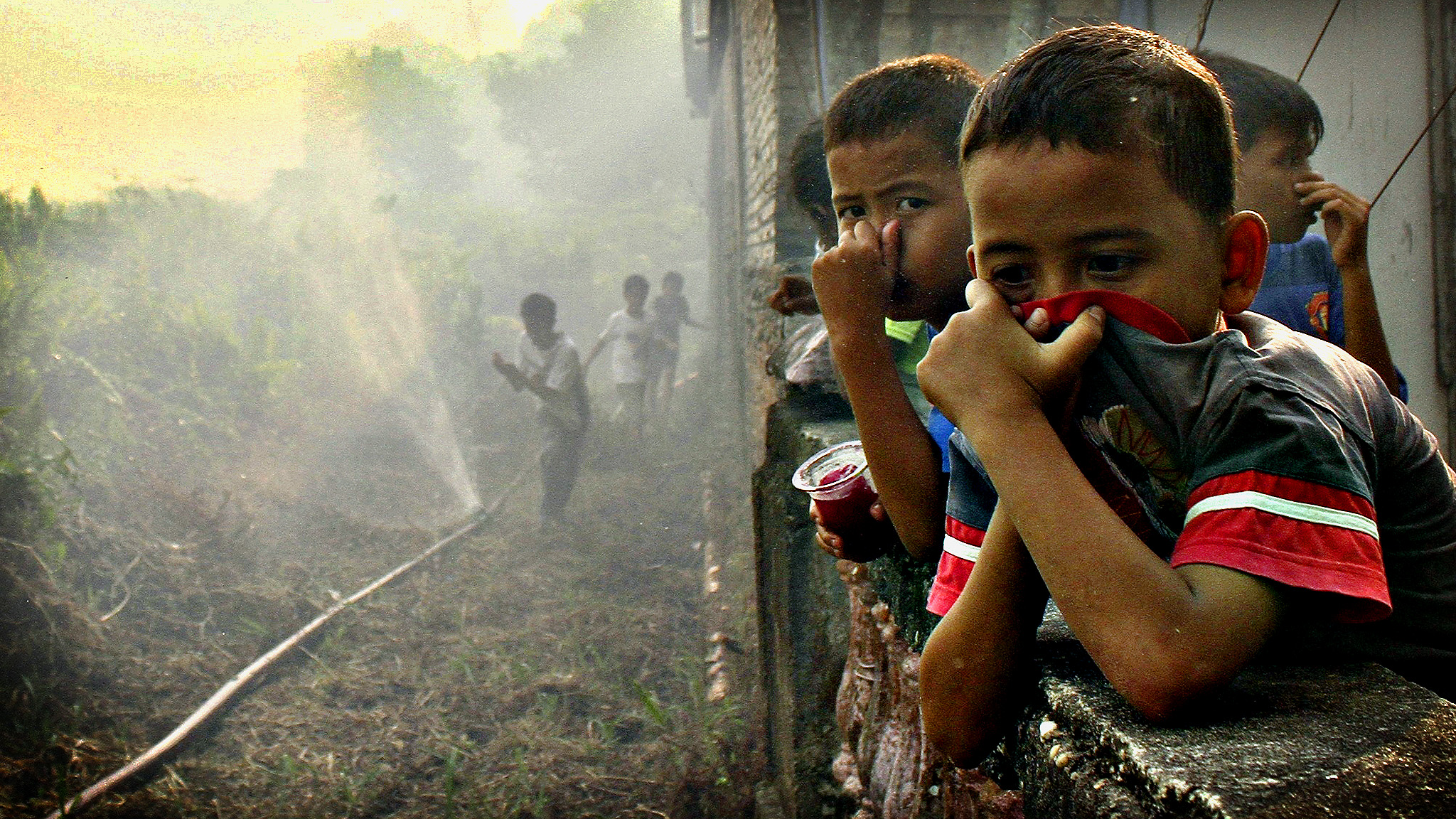- Mammoth Cave National Park in Kentucky is in close proximity to the coal-fired electric utility plants in the Ohio Vallet. Noting this, the National Parks Conservation Association (NPCA) reported that this national park had the poorest visibility of any in the country.
a. What is the connection between coal-fired plants and poor visibility?
Coal contains 1-6% of sulfur. When sulfur is burned with oxygen, sulfur dioxide (SO2) gas is produced. However, even though sulfur dioxide is poisonous, it is colourless and does not impair visibility. The chemical equation of the reaction of sulfur with oxygen is as follows:
S(s) + O2(g) –> SO2(g)
once in the air, the SO2 reacts with oxygen in the atmosphere to form sulfur trioxide gas (SO3) gas which acts in the formaton of aerosols. Aerosols are extremely-fine liquid droplets or solid particles that remain suspended in air as fog or smoke. As a result this causes poor visibility. The chemical equation governing this equation is shown below:
2SO2(g) + O2(g) –> 2SO3(g)
b. The NPCA reported “the average rainfall in Mammoth Cave National Park is 10 estimate the pH of rainfall in the park.
Natural rainfall has a pH of 5.3. pH = -log[H+]. Thus a pH change of 1 unit represents a power of 10 change in [H+].
If the rainfall in Mammoth Cave National Park is 10 times more acidic than natural, it means the pH is 4.3.
2. Here are examples of what an individual might do to reduce acid rain. For each, explain the connection to producing acid rain.
There are two main ways an individual can contribute to the reduction of acid rain.
Firstly, one can contribute by saving electricity. The world generates roughly 40% of its electricity from coal. (explained in question 1, coal contains sulfur, which reacts with air to produce SO2 and SO3. SOx products react with water in rain to produce acide rain. Hence, by reducing our electricity consumption, we can reduce acid rain. a, c and d are ways to save electricity.
Secondly, we can contribute by reducing transport emissions. In the engines of transport vehicles, the high temperature accelerates the reaction between nitrogen gas and oxygen gas.
N2(g) + O2(g) –> 2NO(g)
Once formed, NO is highly reactive and reacts with hydroxyl radical, oxygen and volatile organic compounds to from NO2.
VOC + OH. –> A + O2 –> A’ + NO –> A” + NO2
Where A, A’ and A” are intermediate compounds.
NO2 reacts with rainwater to form acid rain. Hence, by reducing overall transportation emissions, by carpooling or taking public transport, we can reduce acid rain. b and e are ways to reduce transport emissions.
3a. Give names and chemical formulas for five acids and five bases.
Acids:
- Hydrochloric Acid (HCl)
- Nitric Acid (HNO3)
- Phosphoric Acid (H3PO4)
- Sulfuric Acid (H2SO4)
- Carbonic Acid (H2CO3)
Bases:
- Ammonia (NH3)
- Sodium Hydroxide (NaOH)
- Calcium Hydroxide (Ca(OH)2)
- Magnesium Hydroxide (Mg(OH)2)
- Potassium Hydroxide (KOH)
b. Name three observable properties generally associated with acids and bases.
Acids:
- Turns moist blue litmus paper red
- Turns methyl orange red
- Sour taste
Bases:
- Turns moist red litmus paper blue
- Turns methyl orange yellow
- Slippery texture
4. The concerns of acid rain vary across the globe. Many countries in North America and Europe have websites dealing with acid rain. Either search to locate one (“Canada, acid rain”) or use these links to websites in Canada, the UK, or Europe. What are the issues in Singapore? Does the acid deposition originate outside or inside the Singapore’s borders
In the case of Singapore, there was a Straits Times article in 2009 September claiming that an NUS study finds stream in nature reservoir more acidic after downpour. The article concluded that due to increase in acidity, the biodiversity in Singapore’s Bukit Timah Nature Reserve have evolved and adapted to the increasingly acidic environment, but are becoming increasingly stressed. It was reported that the pH value of the water in the stream falls between the range of 4.4 to 4.7.
However, National Parks Board (NPB) Assistant Director wrote in to clarify that tropical stream are naturally acidic. The National Environment Agency (NEA) also defended that they did not detect any increasing trends in rainfall acidity.
In 2013, NEA also addressed a rumour that claimed that cloud seeding or acid rain caused the hail that happened over the western part of Singapore between 1pm and 4.30pm on 25 Jun 2013.
NEA stated that from data backed by Meteorological Service Singapore the hailstones were formed from ball or lumps of ice within intense thunderstorm clouds, and they are different from acid rain, which is rain that contains higher than normal amounts of nitric and sulphuric acids. Hailstones sightings are actually quite rare as they usually melt away before reaching the ground.
An article in 2014 highlighted that with the new system of calculating PSI, Singapore’s air quality fall has fallen below WHO standard. The article also suggested that other than flagging out neighbouring countries as key sources of air polluters, local polluters in Singapore has to be placed in check too. Hence strictly speaking sources of acid deposition may not be only from outside Singapore borders.
A thesis done by a local NTU student identified that Singapore does actually experience acid rain to a certain extent. Findings from two sampling locations, namely NTU and in Hougang, showed an average pH of 4.53 in NTU and 4.61 in Hougang. Which is below the natural pH of rain, which is about 5-6. The lower pH recorded in NTU suggest that acidic ions released are contributed by SOx and NOx from industries located in the western part of Singapore as NTU is in close proximity to Jurong Island and Tuas.
References
http://data.worldbank.org/indicator/EG.ELC.COAL.ZS
http://wildsingaporenews.blogspot.sg/2009/09/native-species-in-singapore-may-be.html#.WMkT1BJ97aY
http://www.haze.gov.sg/faq
https://repository.ntu.edu.sg/handle/10356/54645
http://www.haze.gov.sg/news-releases/haze-talk-clarification-on-hailstones/







